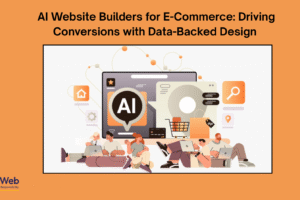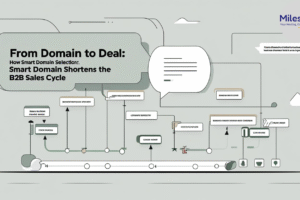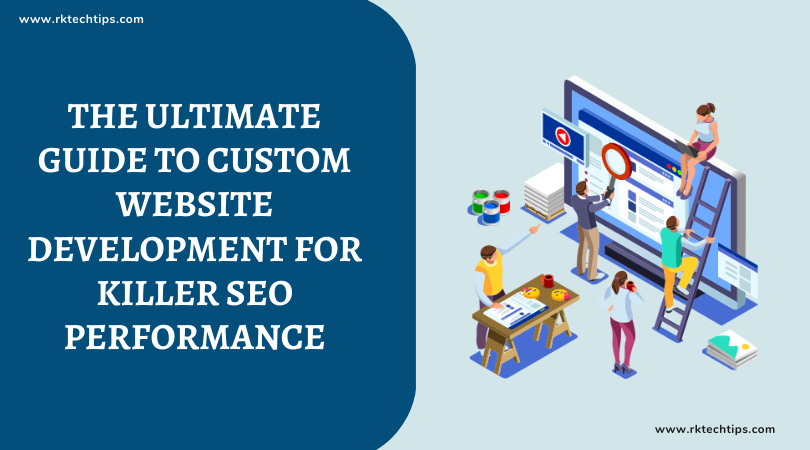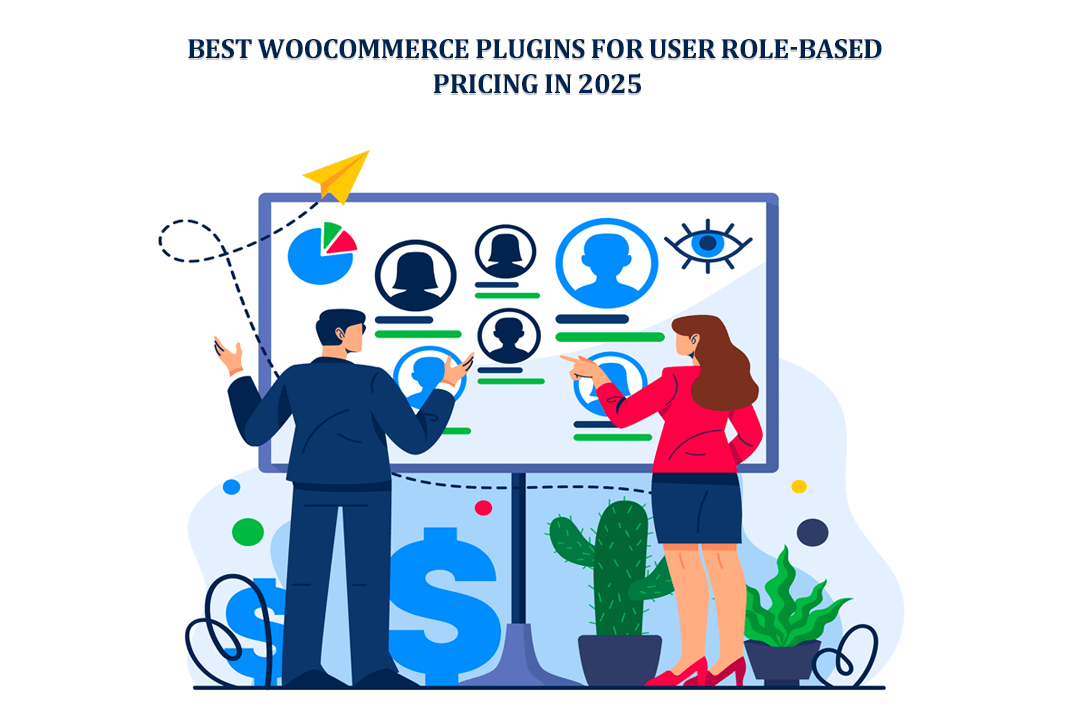In today’s digital age, having a website is no longer optional for businesses looking to grow and succeed. But simply having a website is not enough; it’s important to ensure that your website is optimized for search engines in order to reach your target audience and increase your online visibility.
Custom website development is a key component of effective search engine optimization (SEO) strategies. In this guide, we’ll explore the various aspects of custom website development that can help boost your SEO performance, from choosing the right platform to ongoing maintenance.
Whether you’re a small business owner or a seasoned web developer, this guide will provide you with the tools and knowledge you need to create a killer website that performs well in search engine results pages (SERPs).
What is Custom Website Development?
Custom website development is the process of designing and building a website from scratch, rather than using a pre-designed template or platform.
With custom website development, every aspect of the website is tailored to the specific needs of the business or individual, from the design and layout to the functionality and features.
This level of customization not only provides a unique online presence, but also allows for greater flexibility in terms of SEO optimization, ensuring that the website is optimized for search engines and can effectively reach its target audience.
Importance of SEO Performance for Businesses
In today’s competitive online landscape, businesses must prioritize SEO if they want to stand out and succeed. SEO is the process of optimizing a website for search engines like Google, with the goal of increasing the quantity and quality of traffic to the site through organic search engine results.
By ranking higher in search engine results pages (SERPs), businesses can reach more potential customers and increase their online visibility, which can ultimately lead to increased website traffic, higher engagement rates, and improved conversion rates.
Effective SEO requires a comprehensive approach that includes not only on-page and off-page optimization techniques, but also custom website development that is optimized for search engines.
Understanding SEO
Search engine optimization (SEO) is the process of optimizing a website to improve its visibility and ranking on search engine results pages (SERPs).
SEO encompasses a wide range of techniques and strategies that aim to increase the quantity and quality of website traffic through organic search engine results. The ultimate goal of SEO is to increase the visibility of a website and its content in order to reach a wider audience and drive engagement and conversions.
In order to develop an effective SEO strategy, it is important to have a deep understanding of how search engines work and how they determine the relevance and authority of websites and their content.
By implementing a comprehensive SEO strategy that includes both on-page and off-page optimization techniques, businesses and individuals can improve their online presence and achieve their marketing goals.
Definition of SEO
Search engine optimization (SEO) is the practice of improving the quantity and quality of website traffic by increasing the visibility and ranking of a website or a web page in search engine results pages (SERPs).
It involves a wide range of techniques and strategies that aim to enhance the relevance and authority of a website in the eyes of search engines like Google.
The primary goal of SEO is to help search engines understand the content of a website and determine whether it is relevant to users’ search queries. This is achieved by optimizing various aspects of a website, including its structure, content, and coding, as well as by building high-quality backlinks from other reputable websites.
The end result of effective SEO is increased organic traffic from search engines, which can lead to higher engagement rates, improved conversion rates, and increased revenue for businesses.
How does Search Engines Work
Search engines like Google use complex algorithms to determine the relevance and authority of websites and their content. These algorithms consider a wide range of factors, including keywords, website structure, user experience, backlinks, and many others.
When a user types a search query into the search engine, the algorithm uses this query to determine which websites and web pages are the most relevant and authoritative for the given topic.
The algorithm then ranks these results in order of relevance and authority, with the most relevant and authoritative websites appearing at the top of the search engine results pages (SERPs).
To optimize a website for search engines, it is important to have a deep understanding of how search engines work and what factors they consider when ranking websites.
This knowledge can help businesses and individuals develop effective SEO strategies that improve their online visibility and reach their target audience.
On-Page vs. Off-Page SEO
On-page SEO refers to the techniques and strategies that are applied directly to a website, such as optimizing the content, structure, and coding of the site.
This includes optimizing meta tags, header tags, and images, as well as improving the overall user experience of the site.
Off-page SEO, on the other hand, refers to the techniques and strategies that are applied outside of the website, such as building high-quality backlinks from other reputable websites, social media marketing, and other forms of online promotion.
While both on-page and off-page SEO are important for improving the visibility and ranking of a website, on-page SEO is typically considered the foundation of any SEO strategy. Without a well-optimized website, it is difficult to achieve significant results through off-page SEO alone.
Designing a Custom Website for SEO
Designing a custom website for SEO is an essential part of any comprehensive SEO strategy. A custom website can be tailored to meet the specific needs of a business or individual, including their branding, content, and online marketing goals.
When designing a custom website for SEO, it is important to consider a wide range of factors, including website structure, user experience, content optimization, and mobile responsiveness. By taking a strategic approach to website design and development, businesses and individuals can improve their online visibility and reach their target audience more effectively.
A well-designed and optimized custom website can help businesses and individuals achieve their SEO goals and stand out in today’s competitive online landscape. Let’s get a deeper understanding:
Choose the Right Platform
Choosing the right platform is an essential first step in designing a custom website for SEO. There are a wide range of website platforms available, each with its own strengths and weaknesses.
The most popular website platforms include WordPress, Shopify, Wix, and Squarespace, among others. When choosing a platform, it is important to consider a variety of factors, such as ease of use, customizability, scalability, and cost.
WordPress is a popular choice due to its flexibility and extensive plugin library, which makes it easy to optimize for SEO. Shopify, on the other hand, is a great choice for e-commerce websites due to its built-in e-commerce features and integrations.
Wix and Squarespace are great options for those looking for an easy-to-use website builder that offers a range of pre-built templates and designs.
Ultimately, the right platform will depend on the specific needs and goals of the business or individual, as well as their budget and technical capabilities.
By choosing the right platform, businesses and individuals can build a custom website that is optimized for SEO and meets their specific online marketing goals.
Mobile Responsiveness and Website Speed
Mobile responsiveness and website speed are two critical factors for SEO that should be considered when designing a custom website.
With more and more users accessing the internet on mobile devices, having a mobile-responsive website has become essential for SEO. A mobile-responsive website is designed to adjust to the screen size and orientation of the device on which it is viewed, making it easy to navigate and use on mobile devices.
In addition, website speed is a critical ranking factor for search engines, and a slow-loading website can negatively impact user experience and SEO performance.
To improve website speed, designers should optimize images, minimize HTTP requests, leverage browser caching, and implement content delivery networks (CDNs), among other strategies.
By prioritizing mobile responsiveness and website speed, businesses and individuals can improve the user experience of their website, increase their search engine rankings, and attract more traffic to their site.
Website Architecture and Navigation
Website architecture and navigation play an important role in the design of a custom website for SEO. Website architecture refers to the way in which the content and pages of a website are organized and structured, and can have a significant impact on SEO performance.
A well-organized website structure can improve user experience and make it easier for search engines to crawl and index the site.
This can be achieved through the use of clear page titles, logical hierarchy, and interlinking between pages. Navigation, on the other hand, refers to the way in which users can move through a website to access different pages and content.
Effective navigation can help users find the information they are looking for quickly and easily, improving the user experience of the site.
To optimize website architecture and navigation for SEO, designers should prioritize a clear and logical structure, as well as user-friendly navigation that is easy to understand and use.
By taking a strategic approach to website architecture and navigation, businesses and individuals can improve the visibility and ranking of their site in search engines, as well as the user experience of their website.
User Experience and Accessibility
User experience and accessibility are crucial factors when designing a custom website for SEO. A website that is easy to use and navigate can improve the user experience, encouraging users to stay on the site for longer and engage more with its content.
This can, in turn, signal to search engines that the website is providing valuable content, and can help to improve its ranking. Additionally, ensuring that a website is accessible to all users, including those with disabilities, is not only important for SEO but is also a legal requirement in many countries.
To optimize user experience and accessibility, designers should ensure that the site is easy to navigate, has clear and concise content, and uses images, videos, and other multimedia content where appropriate to enhance user engagement.
They should also ensure that the site is designed to be accessible to all users, including those who may use assistive technologies to access the site. This can be achieved through the use of appropriate coding techniques, such as alt text for images, and ensuring that the site is compatible with assistive technologies such as screen readers.
By prioritizing user experience and accessibility in the design of a custom website, businesses and individuals can improve their SEO performance and ensure that their website is accessible to all users.
On-Page SEO Techniques
In addition to designing a custom website with SEO in mind, on-page SEO techniques can also be used to further optimize a website’s performance in search engine rankings.
On-page SEO refers to the optimization of individual pages on a website, including elements such as titles, meta descriptions, and content.
By optimizing these elements with relevant keywords and providing high-quality, valuable content, businesses and individuals can signal to search engines that their website is authoritative and relevant to user search queries.
On-page optimization also includes technical elements such as the use of header tags, the optimization of images, and the use of internal and external links.
By paying attention to these on-page factors, businesses and individuals can improve their website’s visibility in search engine results pages and attract more organic traffic to their site.
Keyword Research and Targeting
Keyword research and targeting is a key on-page SEO technique that involves identifying the words and phrases that users are searching for and optimizing website content to include those keywords.
By researching and targeting relevant keywords, businesses and individuals can improve their website’s visibility in search engine results pages and attract more relevant traffic to their site.
Keyword research involves identifying keywords that are relevant to the business or topic, as well as considering the competition and search volume for each keyword.
It’s important to select keywords that are both relevant to the business and have a reasonable chance of ranking well in search engine results pages. Once the relevant keywords are identified, they should be included in page titles, meta descriptions, headers, and within the main content of the page.
However, it’s important to use keywords in a natural and meaningful way that provides value to the user. Overuse or “stuffing” of keywords can be seen as spammy by search engines and may actually harm a website’s ranking.
By conducting thorough keyword research and optimizing website content for targeted keywords, businesses and individuals can improve their website’s visibility and attract more relevant traffic to their site.
Optimizing Title Tags, Header Tags and Meta Descriptions
Optimizing title tags, header tags and Meta descriptions is another important on-page SEO technique that can help improve a website’s visibility in search engine results pages.
Title tags and meta descriptions are HTML elements that appear in search engine results and provide a brief summary of the page’s content. Header tags (H1, H2, H3, etc.) are used to indicate the headings and subheadings within a page’s content.
By optimizing these elements with relevant keywords and clear, concise language, businesses and individuals can signal to search engines that their website is authoritative and relevant to user search queries. It’s important to include the targeted keywords in these elements, but also to write them in a way that is informative and compelling to the user.
The title tag and meta description should accurately describe the content of the page and provide an incentive for the user to click through to the site. Header tags should be used to provide a clear and organized structure to the content, and should be optimized with relevant keywords.
By optimizing these on-page elements, businesses and individuals can improve their website’s visibility in search engine results pages and attract more organic traffic to their site.
Content Optimization and Creating Quality Content
Content optimization and creating quality content is a critical on-page SEO technique that involves creating valuable and informative content that is optimized for search engines.
By creating high-quality content that addresses user search queries and provides value to the user, businesses and individuals can improve their website’s visibility and ranking in search engine results pages. Content optimization involves ensuring that the content is organized and structured in a way that is easy to read and understand, and that it includes relevant keywords and phrases.
It’s important to strike a balance between creating content that is valuable to the user and content that is optimized for search engines. Keyword stuffing or overuse can be seen as spammy by search engines and may harm a website’s ranking.
Quality content should be unique, well-written, and provide value to the user. It should be informative and engaging, and encourage the user to spend more time on the site.
Content can be optimized with relevant keywords and phrases, as well as with internal links to other relevant pages on the site.
By creating high-quality content that is optimized for search engines, businesses and individuals can improve their website’s visibility and attract more organic traffic to their site.
Internal Linking and Site Structure
Internal linking and site structure are important considerations when designing a custom website for SEO. Internal linking refers to the links within a website that connect different pages and content together.
A well-structured internal linking system can help search engines understand the hierarchy and structure of a website, and can also distribute “link juice” throughout the site to improve the rankings of individual pages.
Site structure, on the other hand, refers to the overall organization and hierarchy of a website’s pages and content. A well-structured site with clear categories and subcategories can improve user experience and make it easier for search engines to crawl and index the site.
To optimize internal linking and site structure for SEO, designers should ensure that links are relevant and useful to users, and that pages are logically organized within the site’s hierarchy.
This can be achieved through the use of clear category and subcategory names, breadcrumb navigation, and the use of relevant and descriptive anchor text for internal links.
By taking a strategic approach to internal linking and site structure, businesses and individuals can improve the visibility and ranking of their site in search engines, as well as the user experience of their website.
Off-Page SEO Techniques
Off-page SEO techniques refer to actions taken outside of a website to improve its ranking and visibility in search engine results pages.
This can include link building, social media marketing, influencer outreach, and other external marketing efforts.
Off-page SEO is important because it can signal to search engines that a website is authoritative and relevant. By building high-quality external links and engaging with social media and other online communities, businesses and individuals can improve their website’s ranking and attract more organic traffic to their sites.
However, it’s important to remember that off-page SEO is only one piece of the SEO puzzle and should be used in conjunction with other SEO techniques, such as on-page optimization and creating quality content, to improve a website’s overall visibility and ranking. Let’s delve deeper into this point:
Building High-Quality Backlinks
Backlinks are an essential part of off-page SEO because they signal to search engines that other websites consider your content to be authoritative and valuable.
Building high-quality backlinks from reputable and relevant sources can improve a website’s ranking in search engine results pages and increase its visibility to potential visitors.
However, it’s important to focus on quality over quantity when it comes to building backlinks. Low-quality backlinks from spammy or irrelevant sites can actually harm a website’s ranking, while high-quality backlinks from authoritative sources can boost it.
There are several strategies for building high-quality backlinks, including creating valuable and shareable content, guest blogging on other reputable sites, reaching out to influencers or thought leaders in your industry, and engaging with online communities to build relationships and attract links.
It’s important to avoid any black hat SEO tactics, such as buying or exchanging links or using automated link-building tools, which can result in penalties or a loss of credibility.
By focusing on building high-quality backlinks in an ethical and organic way, businesses and individuals can improve their website’s ranking and attract more organic traffic to their site.
Social Media Marketing and Content Promotion
Social media is an important component of off-page SEO because it provides a platform to promote content and build backlinks.
By sharing content on social media and engaging with followers, businesses can increase their online presence, drive traffic to their site, and build relationships with potential customers.
To effectively promote content on social media, it’s important to develop a content strategy that aligns with the business’s goals and audience.
This may involve creating and sharing original content, curating and sharing relevant content from other sources, or a combination of both.
It’s also important to optimize social media profiles with keywords and links to the website, and to engage with followers by responding to comments and messages and participating in conversations.
In addition to social media, businesses can also promote their content through email marketing, influencer outreach, and other online channels.
The key is to create valuable and shareable content that is relevant to the target audience, and to promote it in a way that is authentic and engaging.
By leveraging the power of social media and other online platforms, businesses can improve their website’s ranking and increase their online visibility to potential customers.
Local SEO and Directory Listings
Local SEO is a critical aspect of SEO for businesses that have a physical presence or serve a specific geographic area.
The goal of local SEO is to help businesses appear in the top search results when people search for local products or services.
This is particularly important for small businesses, as it helps them compete with larger businesses and reach potential customers in their area.
One way to improve local SEO is by creating and optimizing directory listings on local business directories such as Google My Business, Yelp, and Bing Places.
These directories provide valuable information about the business, such as its name, address, phone number, and website, and can also include customer reviews and ratings.
By claiming and optimizing these listings, businesses can increase their visibility in local search results and provide accurate and up-to-date information to potential customers.
In addition to directory listings, businesses can also optimize their website for local SEO by including location-specific keywords in their content and metadata, creating location-based landing pages, and building high-quality backlinks from local sources.
By combining these local SEO strategies with other on-page and off-page SEO techniques, businesses can improve their website’s ranking and attract more local customers.
Technical SEO:
Technical SEO includes optimizing website speed and performance, implementing structured data, and ensuring proper indexing by search engines.
Technical SEO can be complex, but it is crucial to ensure that search engines can crawl and index your website properly and that your website is user-friendly and accessible to all users.
By focusing on technical SEO, businesses can ensure that their website is optimized for search engines and provide a seamless user experience for their visitors.
Website Security and HTTPS
Website security is an important aspect of technical SEO that can have a significant impact on a website’s search engine ranking.
One of the most important steps to securing a website is to implement HTTPS, which is a protocol for securely transmitting data over the internet. HTTPS encrypts the data being sent between the user’s browser and the website’s server, making it much more difficult for hackers to intercept and steal sensitive information.
In addition to improving security, HTTPS can also improve a website’s search engine ranking, as Google has indicated that HTTPS is a ranking signal.
By implementing HTTPS on their website, businesses can improve both their website’s security and search engine ranking.
XML Sitemap and Robot.txt File
An XML sitemap is a file that lists all the pages on a website and provides important information about each page, such as when it was last updated and how important it is to the website.
This helps search engines crawl and index a website more efficiently, as it provides a clear structure of the website’s content.
By including an XML sitemap on a website, businesses can help improve their website’s search engine visibility and ensure that their content is properly indexed.
A robots.txt file is a text file that is placed in the root directory of a website and provides instructions to search engine crawlers about which pages on the website to crawl and which to exclude.
This can be helpful in preventing search engines from crawling and indexing pages that may be low-quality or not relevant to a website’s content.
By properly configuring the robots.txt file, businesses can help ensure that their website’s content is properly crawled and indexed by search engines, which can improve their search engine ranking.
Structured Data and Schema Markup
Structured data and schema markup are a set of guidelines for website owners and developers to help search engines better understand the content and structure of their websites.
By using structured data and schema markup, businesses can provide search engines with more information about their website’s content and help improve their website’s search engine ranking.
Structured data and schema markup can be used to provide information about different types of content on a website, such as products, services, reviews, and events.
By using structured data and schema markup, businesses can provide more detailed information about their content to search engines, which can help improve the accuracy of search engine results and drive more traffic to their website.
In addition, using structured data and schema markup can help websites appear as rich snippets in search engine results, which can improve the visibility and click-through rate of a website.
Overall, using structured data and schema markup can be a powerful tool for businesses looking to improve their website’s search engine visibility and drive more organic traffic to their website.
Google Search Console and Website Analytics
Google Search Console is a free tool provided by Google to help website owners monitor and maintain their site’s presence in Google search results.
It allows website owners to see how their site is performing in search, identify and fix any issues, and submit new content for indexing.
By using Google Search Console, website owners can gain valuable insights into how Google crawls and indexes their site, which can help them optimize their site for search.
The tool provides information on search queries, click-through rates, impressions, and other key metrics that can help website owners better understand their audience and improve their SEO performance.
In addition to Google Search Console, website owners can also use website analytics tools like Google Analytics to gain deeper insights into their site’s performance.
These tools provide data on user behavior, traffic sources, and other key metrics that can help website owners make informed decisions about their site’s content, design, and SEO strategy.
By regularly monitoring and analyzing website analytics, website owners can make data-driven decisions that can help them improve their site’s performance in search results.
Ongoing SEO Maintenance
After implementing the various techniques for custom website development and SEO optimization, the work is not done.
Ongoing SEO maintenance is critical to ensure that a website maintains and improves its search engine rankings over time.
This includes regular audits of the website’s performance, checking for broken links, updating content, monitoring keyword rankings, and making necessary changes to keep up with the latest SEO trends and algorithm updates.
Regular website maintenance can be a time-consuming and challenging process, but it is essential to ensure that the website continues to perform well in search engine results and drives organic traffic to the site.
Regular Content Updates
Regular content updates are a critical aspect of ongoing SEO maintenance. Google and other search engines prefer websites that are regularly updated with fresh, relevant, and informative content.
By updating your website with new blog posts, articles, images, videos, or other content types, you signal to search engines that your website is active and relevant to users.
This can help to improve your website’s search engine rankings and attract more organic traffic over time. Moreover, regularly updating your website with high-quality content can keep your visitors engaged, informed, and interested in your brand, products, or services, which can lead to higher conversion rates and revenue.
It is essential to create a content plan and schedule regular updates to keep your website fresh, informative, and relevant to your target audience.
Monitoring Website Traffic and Performance
Regularly monitoring website traffic and performance is an essential part of ongoing SEO maintenance. By analyzing website traffic, businesses can gain valuable insights into user behavior and identify areas for improvement. This information can help businesses refine their SEO strategies and make data-driven decisions for website updates and improvements.
Google Analytics is a powerful tool that can help businesses track website performance and user behavior. It allows businesses to track website traffic, identify popular pages, and understand how users are interacting with the website. By setting up goals and funnels, businesses can also track the performance of specific pages and conversion rates.
In addition to Google Analytics, businesses can also use other tools to monitor website performance, such as Ahrefs and SEMrush. These tools can provide insights into backlink profiles, keyword rankings, and website health.
Regularly monitoring website traffic and performance can also help businesses identify and address technical issues, such as broken links, slow loading times, or crawl errors. By fixing these issues, businesses can improve user experience and enhance their website’s SEO performance.
Addressing Technical Issues and Optimizing for Search Engine Updates
SEO is not a one-time fix but an ongoing process, and it requires constant monitoring and maintenance. Technical issues such as broken links, slow website speed, server errors, and other technical problems can negatively impact your website’s SEO performance. Therefore, it’s essential to address these issues promptly to ensure your website runs smoothly.
In addition, search engine algorithms are constantly updated to provide more accurate and relevant search results. These updates can affect your website’s ranking and traffic. Therefore, you need to stay updated with the latest SEO best practices and algorithm updates to ensure your website remains optimized for search engines.
Regularly auditing your website for technical issues and optimizing it for search engine updates is a crucial part of ongoing SEO maintenance. This way, you can ensure your website remains optimized and visible to your target audience.
Conclusion
Building a custom website with killer SEO performance is crucial for businesses to establish a strong online presence and attract more potential customers. Understanding SEO is the first step towards achieving this goal. It involves knowing how search engines work, on-page and off-page SEO techniques, and technical SEO considerations.
When designing a custom website for SEO, businesses must choose the right platform, ensure mobile responsiveness and website speed, optimize website architecture and navigation, employ internal linking and site structure, and focus on user experience and accessibility.
On-page SEO techniques involve keyword research and targeting, optimizing title tags, meta descriptions, and header tags, and creating high-quality content. Off-page SEO techniques focus on building high-quality backlinks, promoting content through social media marketing, and improving local SEO through directory listings.
Technical SEO is another critical aspect of website development, which includes website security, XML sitemap and robot.txt file, structured data and schema markup, and using Google Search Console and website analytics to monitor website traffic and performance.
Ongoing SEO maintenance requires regular content updates, monitoring website traffic and performance, and addressing technical issues and optimizing for search engine updates.
Building a custom website for killer SEO performance requires expertise and dedication, but the long-term benefits are worth the investment. With a strong online presence, businesses can expand their reach, build brand awareness, and increase revenue.














